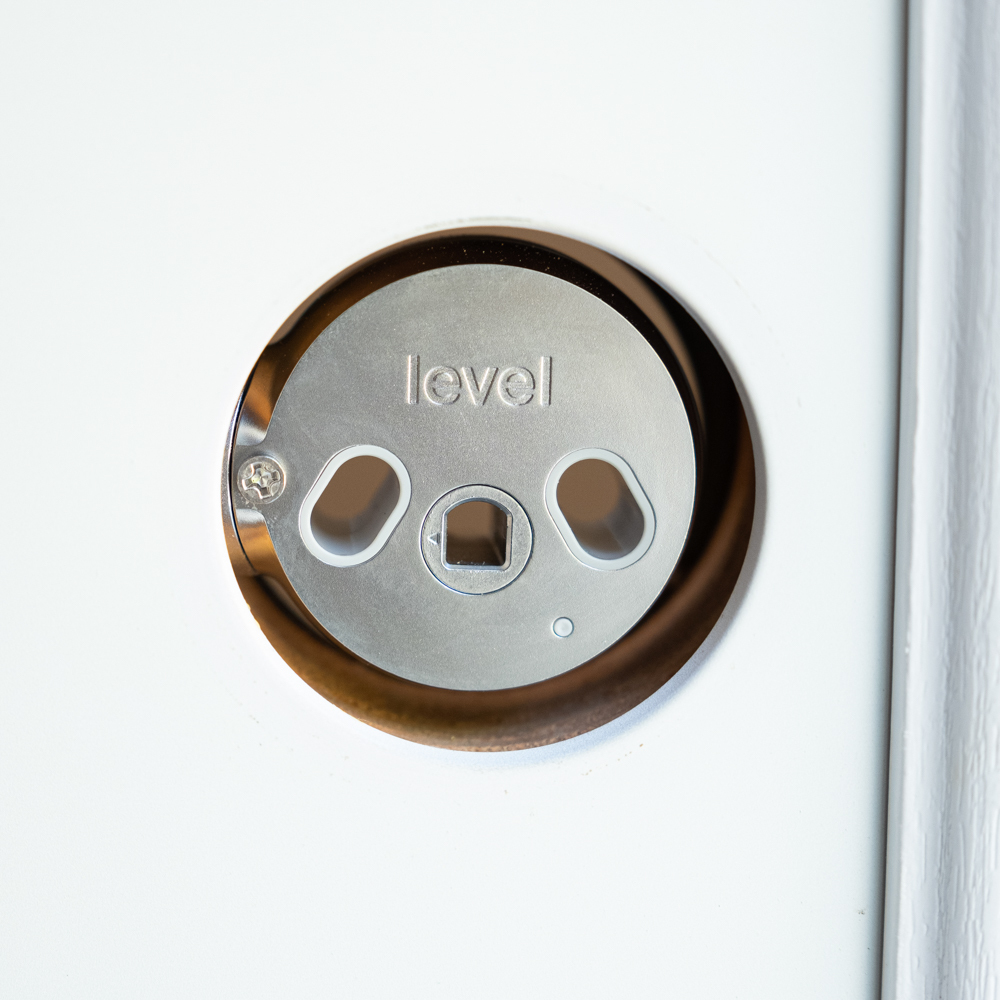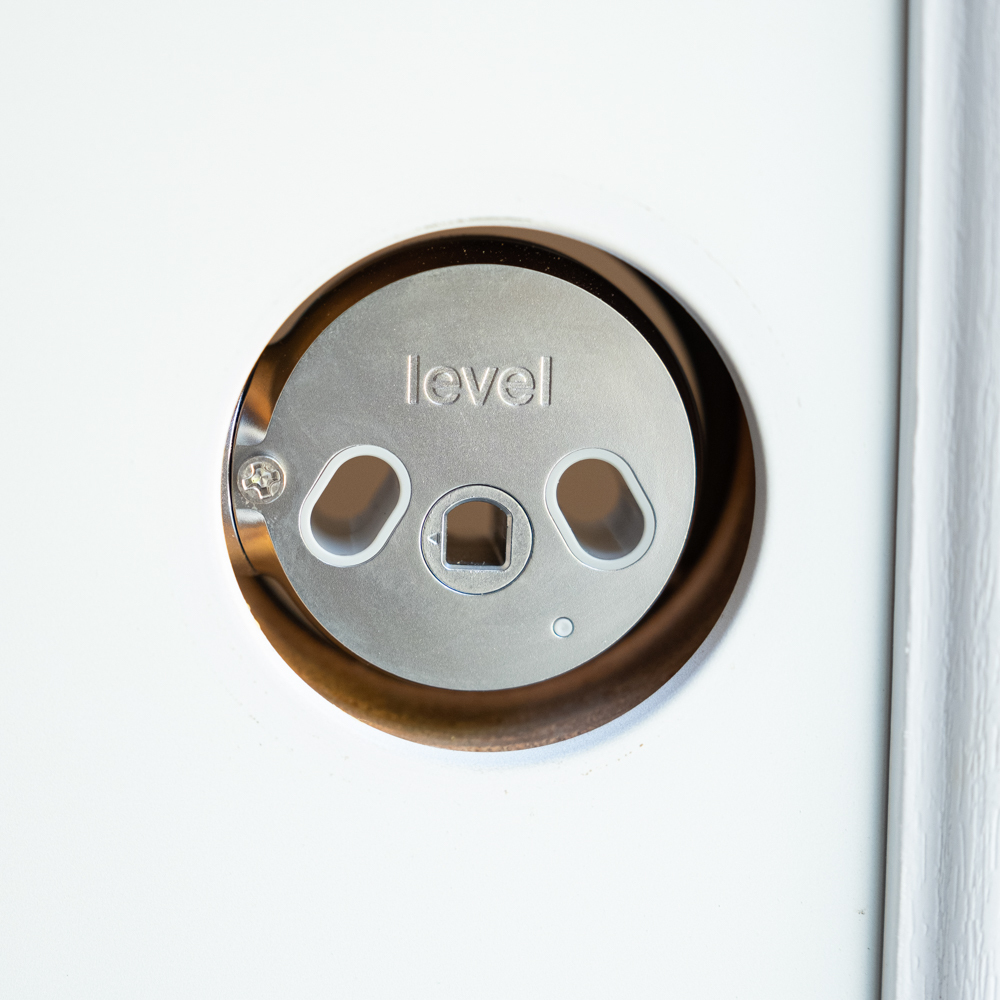Smart locks typically come in two general styles: ones that replace your existing deadbolt and require obvious electronics or interfaces mounted on the inside or outside of the door, or ones that just bolt on top of your existing deadbolt, allowing you to keep most of your original hardware, including your keys. Both designs typically allow you to control the lock with your phone or through automations, but neither is particularly discreet.
The Level Lock is a new smart lock that bucks those trends: once it’s installed, it’s completely invisible and hides all of its electronics and mechanics inside your existing deadbolt lock. It still allows you to open and close the lock remotely with your phone or your voice through Apple’s HomeKit platform (more on this later) or manually with the same key that you’ve always used. But unless you know the Level Lock is there, you’d never suspect the modified deadbolt had any smarts at all. It has the same exterior and interior appearance as before and even the action of manually turning the lever is as smooth as a standard deadbolt with no whirring or grinding from a motor.
At $229, the Level Lock is certainly demanding a premium for its discreet design. And as I’ll get into, it isn’t as fully featured as other smart locks you can buy. If you are really in love with the way your existing deadbolt looks but still want to add some basic smarts to it, the Level Lock is perhaps the one for you.
Verge Score 7 out of 10

Good Stuff
- Invisible design
- Easy installation
- Compatible with most standard US deadbolts
- Long battery life
- Lets you keep your existing keys
Bad Stuff
- Expensive
- Limited feature set
- Only works with Apple HomeKit
- App experience is rough
- No remote control or automation on Android
The Level Lock works by essentially replacing the inner workings of your existing deadbolt, including the bolt itself. The electronics for communicating with your phone (a Bluetooth radio) and the motor necessary to push and pull the bolt open and closed sit in between the existing keyhole on the outside of the door and lever on the inside. You basically take apart your existing lock, remove the inner mechanism and bolt, install the Level mechanism and bolt, and then screw the lever back in. The whole process, including replacing the strike plate on the door frame, takes about 10 minutes.
:no_upscale()/cdn.vox-cdn.com/uploads/chorus_asset/file/20053910/dseifert_200625_4076_0003.0.jpg)
:no_upscale()/cdn.vox-cdn.com/uploads/chorus_asset/file/20053913/dseifert_200625_4076_0001.0.jpg)
Inside the bolt is a CR2 battery that Level claims will last “over a year” before needing to be replaced. You can monitor the battery’s life in the Level app. In the three weeks or so I’ve been testing the lock, it’s never dropped from “full.”
The app itself is extremely basic, and this is where the Level Lock’s limitations begin. You can use the app to create an account, assign the lock to your account, and lock or unlock the door when you are within Bluetooth range. You can also set up an auto-locking feature that will lock the bolt after a set period of time and provide time-limited passes for others to use the lock. Both the iOS and Android versions of the app are essentially identical, with the same sparse (to the point where it almost looks incomplete) design and feature set.
A demo of how the Level Lock works once it’s installed in a deadbolt.
The only smart home platform that the Level Lock works with is Apple’s HomeKit, and you need to have a HomeKit hub (such as an Apple TV, HomePod, or iPad) set up in your home to use it. This is the only way to control the lock when you’re not home or to set up any automations on the lock. It does not work with Amazon Alexa or Google Assistant, at least not as of the time I’m publishing this review. When I asked about other platforms, a spokesperson said the company has “plans to expand support to other platforms in the future but [it’s] not sharing specifics at this time.”
Relying entirely on Apple’s HomeKit platform for any automations or geofencing features (such as automatically unlocking the door when you come home) leaves the Level Lock a bit behind August and other smart locks. In my experience, Apple’s geofencing features aren’t the most reliable. And since you have to manually confirm on the phone each time you want it to unlock the door, it’s not nearly as automatic or seamless as the August’s automatic unlocking. The Apple Home app can also take a long time to communicate with the Level Lock to determine its status or issue it a command. On the other hand, voice control of the lock via Siri works well and doesn’t suffer too long of a delay from when I say a command and the lock responds. The lock makes an audible chime whenever it successfully opens or closes the bolt.
:no_upscale()/cdn.vox-cdn.com/uploads/chorus_asset/file/20055813/level_lock_app_4up.png)
Since the Level Lock only works with HomeKit, I wouldn’t bother with it if you’re an Android user. You’d have no way to control it when out of the house or set up any automations. The only thing you could do is push a button in the Level app when you’re within Bluetooth range to lock or unlock the door.
Level Lock’s limitations are frustrating in general, and if I were looking at a smart lock for my main entrance, I’d probably go with one of the more fully featured locks available, even if they are complete eyesores in comparison. As a technological endeavor, though, the Level Lock is very impressive, and it points toward a time when we can have all kinds of smart technology embedded in our homes without being reminded it’s there every time we get home. It’s just not quite there yet.
Photography by Dan Seifert / The Verge
